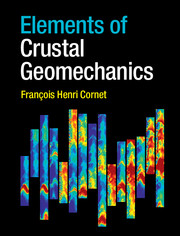Book contents
- Frontmatter
- Epigraph
- Contents
- Preface
- 1 Geomaterials and crustal geomechanics
- 2 Elements of rheology
- 3 Forces and stresses
- 4 Elements of kinematics
- 5 Elements of linear elasticity
- 6 From continuum mechanics to fluid mechanics
- 7 Elements of linear fracture mechanics
- 8 Laboratory investigations on geomaterials under compression 183
- 9 Homogenized geomaterials
- 10 Fractures and faults
- 11 Elements of seismology
- 12 Elements of solid–fluid interactions
- 13 Methods for stress field evaluation from in situ observations
- 14 Elements of stress fields and crustal rheology
- Appendix Elements of tensors in rectangular coordinates
- References
- Index
14 - Elements of stress fields and crustal rheology
Published online by Cambridge University Press: 05 April 2015
- Frontmatter
- Epigraph
- Contents
- Preface
- 1 Geomaterials and crustal geomechanics
- 2 Elements of rheology
- 3 Forces and stresses
- 4 Elements of kinematics
- 5 Elements of linear elasticity
- 6 From continuum mechanics to fluid mechanics
- 7 Elements of linear fracture mechanics
- 8 Laboratory investigations on geomaterials under compression 183
- 9 Homogenized geomaterials
- 10 Fractures and faults
- 11 Elements of seismology
- 12 Elements of solid–fluid interactions
- 13 Methods for stress field evaluation from in situ observations
- 14 Elements of stress fields and crustal rheology
- Appendix Elements of tensors in rectangular coordinates
- References
- Index
Summary
An evaluation of the relative significance of fractures and faults for the deformation processes of rock masses is provided by an examination of the stress field within the volume of interest.
When stress perturbations associated with these surfaces of weakness are only local, so that the stress field may be modeled by continuous functions defined within the whole volume of concern, it may be concluded that continuum mechanics provides a sound paradigm for understanding geomechanics issues. However, when the definition of continuous functions for the description of the regional stress field becomes too approximate, a different approach, such as for example the discrete element method (Cundall, 1988; Hart et al., 1988; Shi and Goodman, 1988), may be found more appropriate.
We discuss below four examples of the stress field evaluations that have been conducted at different length scales. The objective is to explore whether the concept of stress as defined in continuum mechanics has been shown to be helpful for these examples and how stress field modeling may shed some light on loading, boundary conditions and rheological behavior.
We present, first, the results from a stress determination project conducted for the design of an underground hydraulic power station in northern Portugal (Figueiredo et al., 2014). The scale is in the km3 range, the material is a homogeneous granite and the region is mountainous.
Then we consider a stress determination conducted in the sedimentary Paris Basin (Wileveau et al., 2007; Cornet and Röckel, 2012). The volume of interest is about 15 km × 15 km × 0.8 km and involves a series of limestones, shales and clays.
This discussion is followed by a presentation of results gathered in the upper Rhine graben, in the vicinity of the city of Basel in Switzerland, where data are available for a volume approximately equal to 50 km × 50 km × 15 km (Cornet and Burlet, 1992; Valley and Evans, 2009; Maury et al., 2013).
- Type
- Chapter
- Information
- Elements of Crustal Geomechanics , pp. 399 - 430Publisher: Cambridge University PressPrint publication year: 2015



